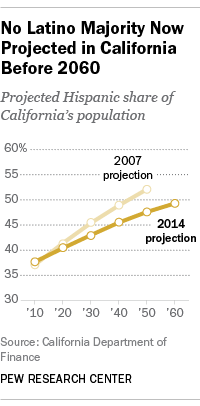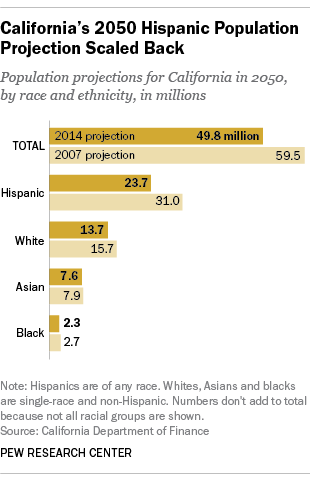California reached a milestone in 2014 when it became only the third U.S. state where white non-Hispanics were outnumbered by another racial or ethnic group. At about 15 million, Hispanics for the first time constituted California’s largest racial or ethnic group, according to the state’s Department of Finance.
 However, it could be a half-century (or longer) before Hispanics become a full majority in California, if that demographic milestone is reached at all, according to scaled-back state population projections published by the state Finance Department.
However, it could be a half-century (or longer) before Hispanics become a full majority in California, if that demographic milestone is reached at all, according to scaled-back state population projections published by the state Finance Department.
Under projections published in 2007, the state’s Hispanic population was expected to reach 31 million in 2050, or 52.1% of all Californians. But according to updated projections released late last year, Hispanics are now expected to number 23.7 million in 2050, or 47.6% of all Californians. That pushes the prospect of a Hispanic demographic majority further into the future – perhaps to sometime after 2060.
The 2014 population projections also included an estimate for 2060 that indicates that Hispanics may not reach a majority by that year, when they are expected to number 25.5 million, or 49.3% of California’s population.
This change in the projected growth of the Hispanic population is driven by a number of factors. California has long been a top destination for immigrants from Latin America, but immigration from Latin America to the U.S. began to slow in 2008 due in part to the Great Recession. As a result, national Hispanic population growth today is driven more by U.S. births than by the arrival of new immigrants. At the same time, birth rates are falling among Hispanic women.
 California’s total population projections have also been reduced. In 2007, the state’s population had been projected to reach 59.5 million in 2050. But now, the latest projections say the population will reach 49.8 million in 2050, about 10 million less than the earlier projection.
California’s total population projections have also been reduced. In 2007, the state’s population had been projected to reach 59.5 million in 2050. But now, the latest projections say the population will reach 49.8 million in 2050, about 10 million less than the earlier projection.
This lower projected population shows how California’s demographic future will continue to be tied to Latinos, a group that for decades has played a key role in the state’s demographics. Since 1980, Hispanic population growth has accounted for about two-thirds of the state’s overall population growth, helping California gain eight new congressional districts over the period. (However, seven of those seats were gained before 1990.)
Today, California is the nation’s most populous state, with more than 38 million residents. It has the nation’s largest Hispanic population by far, with about 15 million Hispanic residents, accounting for 38% of the state’s population. (Texas is a distant second, with 10 million Hispanics, and Florida is an even more distant third with just 5 million Hispanics.)
California’s lowered Hispanic population projections mirror national projections. The U.S. Census Bureau has reduced Latino population projections by nearly 30 million by 2050 compared with those published in 2008. The bureau has also lowered the overall U.S. population projection for 2050 by about 40 million compared with 2008.




